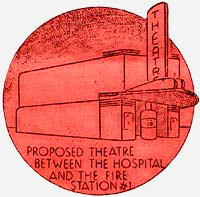 Films, plays and music were popular in the camps. (Image: Daily Tulean Dispatch, Oct. 1, 1942, Folder 2, Box 5, Gov. Sprague Records, OSA)
Films, plays and music were popular in the camps. (Image: Daily Tulean Dispatch, Oct. 1, 1942, Folder 2, Box 5, Gov. Sprague Records, OSA)
Two worlds existed simultaneously in some relocation camps. For one, there was the idealized world of American life with many of the attendant hopes and dreams, albeit behind barbed wire. In the minds of many internees, this included a hard day's work in the mess hall or on the farm project combined with a schedule of social and leisure activities, thus forming a tolerable confinement facsimile of "outside" life. Obviously, some people were better at compartmentalizing the frustration of internment and making the best of the situation, In this world, residents were loyal and patriotic, in spite of what their country had done to them. Many began their days by pledging allegiance to the American flag. But for others, a second and darker world of anger and resentment developed toward a government that deemed them guilty until proven innocent -- against a nation that rejected them.
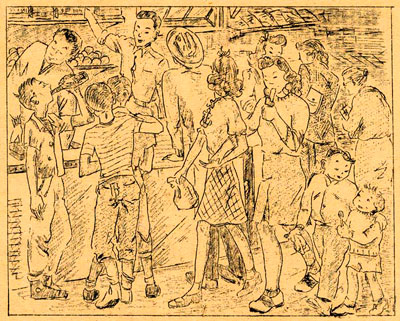 Young Japanese Americans liked spending time at the canteen as this camp drawing shows. (Image: Daily Tulean Dispatch, Oct. 1, 1942, Folder 2, Box 5, Gov. Sprague Records, OSA)
Young Japanese Americans liked spending time at the canteen as this camp drawing shows. (Image: Daily Tulean Dispatch, Oct. 1, 1942, Folder 2, Box 5, Gov. Sprague Records, OSA)
Internees tapped into a range of recreational outlets to break the routine of camp life and maintain positive social connections with their neighbors. As in the "outside" world, sports proved extremely popular, and baseball was king. Often, residents from the same city would form a team and join a league. So it was that the Tacoma Busseis "swamped Auburn A.C. by an 11-2 count" to win the Tule Lake League baseball playoffs. The Tacoma squad had earlier defeated teams from Hood River, Oregon and Marysville, California.
Footnote 1
Softball, volleyball, football and ping pong were just a few of the sports played. Clubs and classes added to the mix. For example, the
announced that barbell club members were urged to attend an "important meeting." Meanwhile, fencing classes were offered four nights a week.
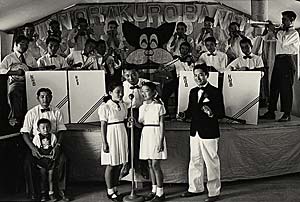 The Norakuro Band, led by Roy Matsunaga of Portland, was a popular fixture at Minidoka Relocation Center dances. (National Archives, image no. ARC 539490)
The Norakuro Band, led by Roy Matsunaga of Portland, was a popular fixture at Minidoka Relocation Center dances. (National Archives, image no. ARC 539490)
Camp residents
showed great ingenuity devising entertainment options. The Tule Lake Symphony performed, as did Woody Ichihashi's dance band, the Downbeats, which played
popular tunes of the day from the likes of Glenn Miller and Woody Herman. Ichihashi's busy orchestra served double duty as part of the Cafe International Cabaret that made the rounds to the
wards in the Tule Lake camp. The cabaret also featured "gaily attired Tri-State girls. [And] the program is packed full of music and dances...." Numerous other events such as Halloween masquerade balls, pageants, art shows, films, recitals and plays rounded out the social and performance schedules for many residents.
Footnote 3
Leisure time was also spent around the community canteens of the center. These canteens joined stores, barber shops, flower shops, gardens
and other venues to provide valuable services and gathering spots for internees. Canteens, in particular, were magnets for younger residents as the Daily Tulean Dispatch noted:
The newspaper also noted a "surprising amount of ice creams, pops, pastries, and candies are sold daily."
Footnote 4Cynicism and Resentment Rise to the Surface
Despite leisure activities and other diversions, cracks soon appeared in the idealized camp life facade. Some were minor, such as the "unthinking boys" who removed the plumbing fixtures from washrooms at the Minidoka camp.
Footnote 5 But larger strains were evident as well. Governor Sprague dispatched Hugh Ball to Tule Lake in October 1942 to assess the camp. Ball, who was a newspaper editor from Hood River and knew many of the internees, wrote a long report in which he described a rift: "The older folks accepted their situation with Shikata ga nai ('It can't be helped') - but they do deplore the breakdown of morale among their children in the camp, and it is evident that parental control, in many instances, has fallen to a low ebb." Later, during a conversation with younger men, Ball "discovered what is wrong" at the camp and why many refused to pursue crop work opportunities outside the camp:
Ball wished he could report that these were only "smart alecs" showing off to their fellow internees, but he was forced to conclude otherwise. He noted that these "formerly active young men, largely raised in conformance with American ideals" were now inmates with plenty of time to mourn their fate "and to listen to a relatively small group, members of which are, by propaganda, keeping the old wound open and smarting at all times, and doing their worst to convert these young men into potentially dangerous enemies."
Footnote 7The Lid Comes Off
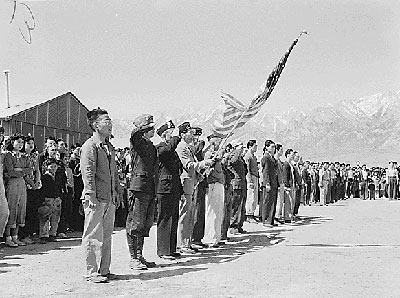 Patriotic ceremonies with boy scouts and American Legion members, such as these at the Manzanar Relocation Center in California, were in stark contrast to the demonstrations and riots served up by some internees. (National Archives, image no. ARC 538506)
Patriotic ceremonies with boy scouts and American Legion members, such as these at the Manzanar Relocation Center in California, were in stark contrast to the demonstrations and riots served up by some internees. (National Archives, image no. ARC 538506)
Frustration continued to build with strikes and protests until rioting eventually erupted at Tule Lake in the spring of 1943. This was preceded by a serious disturbance at Manzanar in December 1942 between the supporters and opponents of the WRA administration in which two people died and at least ten were wounded by military police gunfire. Just a few months later, an "epidemic of rioting...broke out at the Tulelake Center and continued for nearly six weeks," apparently triggered by an inquiry into the allegiance of internees on a questionnaire.
Footnote 8
A newspaper report captured the scene: "Before the end of the trouble bands of hoodlums roamed up and down the camp's streets, breaking into homes and attacking the occupants. The Japanese *** who were in cooperation with the administration were nearly killed, and two Christian Priests were badly beaten. A Jap flag mysteriously appeared and, as mysteriously disappeared. The army moved in, followed by the FBI. There were mass arrests, and one hundred men were thrown into near-by jails and deserted C.C.C. Camps. When the prisoners were carried off they were surrounded by howling Japanese who yelled, 'Banzai!'" One official declared: "You can't imagine how close we came to machine-gunning the whole bunch of them..."
Footnote 9Loyalty Questions
The events at Tule Lake and Manzanar involved a relatively small percentage of the
population in the camps and they represented extreme examples of resentment in the Japanese American community. Still, while most abhorred the violence, many identified with the frustration. Some internees found less open ways to express their pro-Japan sentiments. For example, Manzanar internee workers scratched inscriptions into the wet concrete of the settling pond they were building that read: "Beat Great Britain and the USA" and "Banzai, the Great Japanese Empire..."
Footnote 10
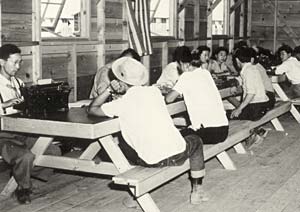 Japanese American men register for the draft at a Selective Service headquarters in the Tule Lake camp in 1942. (Image j11DD-38A courtesy Bancroft Library. University of California, Berkeley)
Japanese American men register for the draft at a Selective Service headquarters in the Tule Lake camp in 1942. (Image j11DD-38A courtesy Bancroft Library. University of California, Berkeley)
A government questionnaire revealed frustration and confusion about the issue of loyalty. One question asked if internees wanted to renounce their U.S. citizenship and 5,589 said yes. Most of the renunciations were determined in subsequent hearings to be invalid because of what many considered to be the coercive conditions in which they were obtained. Moreover, the question of renouncing their Japanese citizenship as a show of loyalty to the United States caused problems for many first generation Japanese immigrants. Some respondents had difficulty answering because of their limited English language skills. Others knew that if they renounced their Japanese citizenship, they would become stateless persons since U.S. law denied them citizenship. In the end, many of the 1,327 who were expatriated to Japan were not accepted by the Japanese government.
Footnote 11
Military Service
Not surprisingly, given their treatment by the government, most young male internees expressed little interest in serving in the military. A questionnaire at the Tule Lake camp asked how many of the 6,000 to 7,000 men who were qualified would volunteer for military service and only two responded favorably.
Footnote 12 Overall in camps, only 6% of military-aged men who responded to a questionnaire said they would volunteer for military service. Yet most of those who refused said that they would be willing to serve if their rights were restored. They complained about a government that would take away their freedom and rights as citizens while asking them to fight for the freedom and rights of others.
Footnote 13
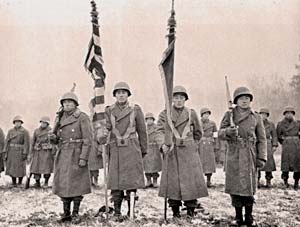 Members of the highly decorated Nisei 442nd Regiment stand at attention during service in Italy. The 442nd was an all-volunteer unit. (Image courtesy latinamericanstudies.org)
Members of the highly decorated Nisei 442nd Regiment stand at attention during service in Italy. The 442nd was an all-volunteer unit. (Image courtesy latinamericanstudies.org)
In spite of widespread misgivings about their treatment, many young Japanese American men signed up when the Army announced in 1943 that it would accept volunteers for the 442nd Regimental Combat Team, an all-Nisei combat unit created to serve in Europe. About 3,000 volunteered and passed loyalty interrogations before acceptance on the team. The unit went on to be one of the most highly decorated in American history. Among other courageous actions, the 442nd gained fame for saving the 141st or "Lost Battalion" from the German forces. In 35 minutes the 442nd rescued 300 soldiers from Texas who had been surrounded for a week. The bloody fight left the 442nd with 60% casualties but earned them honorary Texas citizenship bestowed by grateful Texans.
Footnote 14
Overall, about 8,000 Japanese American men, many draftees, served in the military during the war. A sizable number served as Japanese language interpreters with the Allies in the South Pacific, particularly in the latter stages of the war. There they translated captured enemy documents, helped to interrogate Japanese prisoners or war, and eavesdropped behind enemy lines. Japanese American women also volunteered from the camps to serve in the Women's Army Corps and the Red Cross.
Footnote 15Related Document
Notes